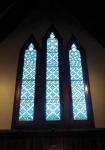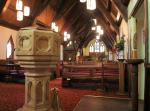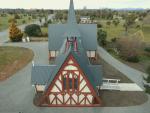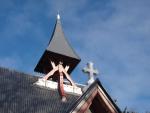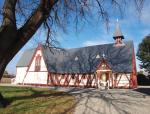Saint Bartholomew’s Church: A Church on the move
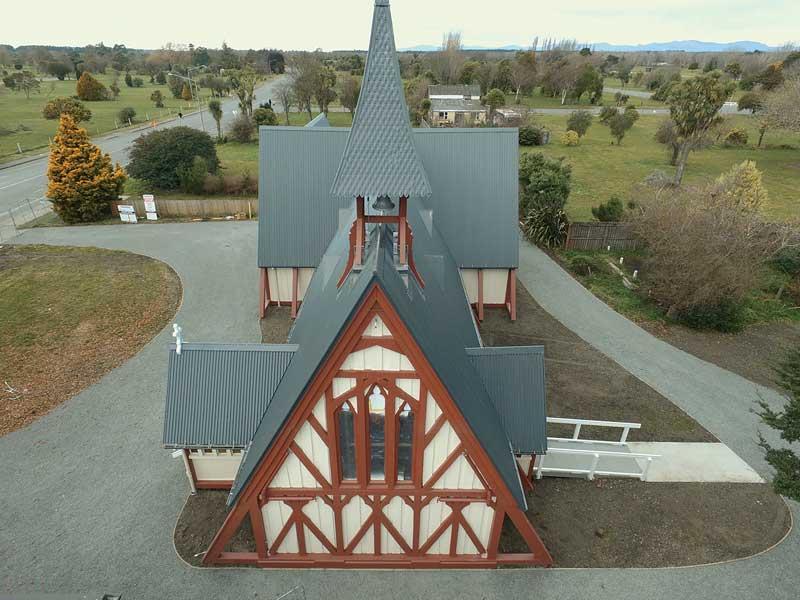
St Bartholomew’s Church dates from 1855 and is the oldest timber church in Canterbury. It was designed by the renowned architect of the day, Benjamin Woodfield Mountfort and followed an earlier timber and brick church, located in Lyttelton, in the South Island. This particular church had been destroyed by high winds and this event influenced the “A” frame design of St Bartholomew’s. Little did Mountfort know at the time the strength of his design would also be subjected to, and tested by, the September 2010, 7.1 magnitude Christchurch earthquake felt in the Kaiapoi region 150 years later.
Four years after the building was completed, in 1859-60, the sandy sub-soil beneath the church began to subside and required the entire building to be relocated to a more stable site. Years later, as a result of the earthquakes of 2010 -11 the foundations to the church settled and a decision was made to move the church yet again. This time the move was only a temporary measure while new foundations were constructed. Once the work to the foundations had been completed, the church was moved back again. It is now fondly referred to locally as “a church on the move.”
Dave Pearson, of DPA Architects in Devonport, was appointed by the Christchurch Anglican Church Property Trustees to repair the damage caused by the earthquakes and remediate any deferred maintenance. The practice specialises in heritage building conservation and is committed to preserving New Zealand’s history and culture.
Suzanne Price, manager of the Recovery Programme for the Anglican Church Property Trustees, speaks highly of the expertise and commitment Dave brought to the project. “As the project progressed it was discovered that many unforeseen aspects of the building required attention. A decision was made to completely refurbish the building rather than do a “patch-up” job that would require additional work in the future. Dave’s passion for heritage buildings proved invaluable in the execution of the various work required.”
This work schedule was extensive and included virtually every part of the building from the foundations to the belfry and much of what was in-between.
Suzanne’s passion for St Bartholomew’s Church is also evident as she explains, “As a child I was raised in Kaiapoi and St Bartholomew’s Church was my church, the church I attended, grew up with and loved. I was fortunate to be a part of the restoration team. The repair and restoration has been enormously challenging but it is wonderful to see how it looks now with a new roof, a complete repaint, restored windows and the magnificent interior timber beautifully oiled and restored.”
Our insurance funds covered only part of the earthquake damage costs. The Canterbury Earthquake Heritage Building Fund grant met the balance of the EQ repair costs with the Lottery Grants Board Environment and Heritage Fund meeting the restoration costs.
Once the decision was made to move the church to enable a complete rebuild of the foundations, all the heavy items such as the church pews and the fragile, and precious, church organ had to be removed from the church for safe keeping.
The church was moved by Heritage House Relevellers and managed by director Lindsay Smith. It was jacked off its original foundations using pneumatic jacks and steel whalers were then placed beneath to support the building. Wheeled bogies were positioned under the whalers and the building was pulled along timber rails. “Once up on its rail track the building was moved aside surprisingly quickly,” says Suzanne. “It seemed to move at about one metre every five minutes and was quite spectacular to watch.”
The original intention was to replace part of the roof and then to repaint the entire roof. As with many restoration projects what lay beneath the existing paintwork was not apparent until work started. The existing roof had been treated, at some time in the past, with a bituminous product and even after extensive preparation it was impossible to remove. The new paint would not adhere to it and simply blistered off on the entire east side of the roof. As this is a very steeply pitched roof, and repainting it in the future would prove expensive and difficult, a decision was made to reroof the entire building using a pre-painted corrugate profile to match the original profile. The soft lines and colour of Roofing Industries “True Oak” met the brief perfectly.
The timber belfry is an intricate structure supported on posts that go through the roof to be connected to the main roof beams. There was considerable decay present in some of the timber members both within the belfry and the church below and the decision was made to remove the belfry for repair and restoration. The belfry was craned off the building and both it and the church were repaired, both no small feats.
Once the belfry was restored a decision had to be made about water proofing around the timber supports. Previously lead was used to flash around the posts and it was recognised that there could be metal incompatibility issues between the lead and the new corrugated roofing. In reality, there was no alternative. If and when corrosion occurs, and some sheets of corrugated steel immediately below the belfry need to be replaced, it is seen as an acceptable risk, given the alternative of regular painting.
“The lead flashings on the belfry are a work of art and well worth preserving despite the possible drawbacks”, says Suzanne,” and considerable care was taken to isolate the two metals as far as possible”.
The sheathing of the belfry presented another potential dilemma. Originally, the belfry, like the roof of the church was apparently clad with timber shingles. At some stage the church was reroofed with Marseilles clay tiles and the belfry with a zinc coated steel pressed into a “fish scale” pattern. Although it is no longer possible to obtain pressed zinc sheets, similar patterned sheets are made in Australia from aluminium. Again, there were potential issues with incompatibility, and the sheets had to be well painted to reduce any risk of failure.
The stained-glass windows in the church are in themselves works of art that are highly valued by the parish. The windows within the sanctuary are believed to have been made in London around 1883 and feature the Sermon on the Mount and the Four Evangelists. The windows at the end of the nave are leadlights which may date from the time the church was originally constructed. Some damage was caused to the windows by the earthquakes and work was required on all of them. The stained-glass windows and the leadlights at the end of the nave were temporarily removed and restored by Graham Stewart of Stewart Stained Glass in Loburn, Canterbury. The leadlight windows in the two transepts were completely rebuilt.
The church is reputed to have been constructed of Totara and Black Pine (Matai) obtained from the nearby bush. These timbers were probably used for the main structural members. Kauri is also present, complete with evidence of termites, now hopefully dead. The external walls appear to have been sheathed with Kahikatea, a timber that is less durable and susceptible to borer attack.
Over the years, water had caused decay in some of the structural members. All decayed timber was removed and Purple Heart, a sustainably milled timber from Central and South America, was spliced into existing sound timber members.
“The main contractors on the project were Simon Construction and the carpenter on the project was a true craftsman and did an exceptional job of the timber restoration,” says Suzanne, “ particularly given our very limited budget to complete the project.”
The interior of the church is magnificent and belies the rather plain and humble exterior. Beautiful solid beams and braces together with the completely sarked ceiling gives a warm and friendly ambience befitting a place of worship. As part of the project, the entire interior of the church was oiled and brought back to its original glory.
St Bartholomew’s Church spokesman, Stephen Walters says, “The project has been “a ground up restoration”, from repairing native timbers, such as kahikatea used in the original build, to fixing the “precarious” steeple and belfry. There isn’t one aspect of the building which hasn’t had attention and it is all the better for it. It is now preserved for future generations, but it’s not a museum, it’s a working space that we all enjoy.”
The Anglican Church Property Trustees have 290 buildings held in trust. 234 sustained earthquake damage in the Christchurch earthquake including 50 of the 55 vicarages. Of these 152 projects have been completed with 20 in progress and 30 in the planning stages.


